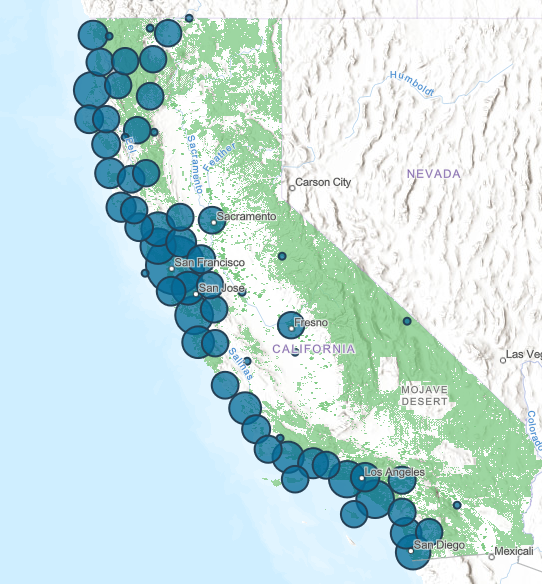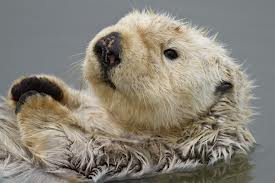San Francisco Bay Living Shorelines Project
Coastal Conservancy & 17 regional partners
Project Description
At two locations, the San Francisco Bay Living Shorelines Project is demonstrating the potential of establishing native eelgrass and oyster beds to protect the San Francisco Bay shoreline while creating biologically rich and diverse habitat that is resilient to changing environmental conditions.
Habitats created through the project were quickly shown to benefit a wide variety of wildlife while decreasing energy from wave action. The decreased wave energy reduces flooding and erosion of the shoreline and allows sediments to accrete, enabling the shoreline to rise along with sea levels.
Findings from this project are being used to design future projects and develop best practices for managing living shorelines and submerged habitats.
Design
- Oyster shell-bag mounds and eelgrass beds were planted 150-250 meters offshore and are being monitored to observe their biological and physical effects and impacts as living shorelines.
Monitored: Wave attenuation, sediment accretion, bird and fish utilization, and water quality
Four alternatives to oyster shell-bag mounds were tested as structures for oyster settlement (due to scarcity of shells for shell-bag mounds).
- Monitored: Oyster recruitment and growth
Construction
- Sites were chosen 150-250m offshore, dependent on slope, to achieve eelgrass’s preferred depth; oysters can tolerate higher tidal elevations.
- Site access had to be carefully planned in order to access shallow subtidal environments.
- More than half a million clean oyster half shells (six semi-truck loads) were used to build reefs.
- Eelgrass was transplanted from different sites to test which donors performed best.
Results
Oyster Settlement Results
Physical Benefits
- Reefs reduced 30-50% of wave energy.
- Sediment accumulated 15 cm around oyster shell bags and 24 cm inside.
Biological Benefits
- Many rare and valuable species such as black oystercatchers, dungeness crabs, and steelhead were quickly attracted to the site.
Eelgrass Restoration Results
- Eelgrass transplanted from Point Molate was more successful than donors from Point San Pablo due to similar muddy conditions.
- The ephemeral nature of beds in San Francisco Bay may require ongoing restoration maintenance.
Combination of Oyster and Eelgrass Beds
- Combining oyster and eelgrass beds in one project site increases the diversity of fish and invertebrates using the site, but oyster beds should be spaced apart because of a trending negative impact on eelgrass (likely due to competition for space).
Each location is unique, and site-specific characterizations should be considered in the shoreline design.
Future Research: Test more locations and designs and test the reduction of wave energy at other locations with different slopes, fetch, and sediment types. Look for other sources for shells for shell bags (e.g., develop a shell recycling program).
Costs: $2.1 million ($400k for design and permitting, $450k for construction, $1.25M for monitoring)
Timeline: Design & Pre-project monitoring, 2011-12; Permitting, 2012; Construction, summer 2012; Monitoring, 2012-present
Partners: US EPA, NOAA, USGS, Coastal Conservancy, CA Dept. of Fish and Wildlife, Wildlife Conservation Board, UC Davis, SF State University Romberg Tiburon Center, San Francisco Estuary Partnership, The Nature Conservancy, CA Wildlife Foundation, ESA/PWA, Dixon Marine Services, Drakes Bay Oyster Company (shells)
For more information visit the Living Shorelines Website or contact Marilyn Latta, State Coastal Conservancy on 510-286-4157
Photo credits: Marilyn Latta, Stephanie Kiriakolopolos, Susan de la Cruz
Latest News
- Press Release: Coastal Conservancy Awards over $40 million for coastal access, restoration, and climate resilienceOakland, CA (4/18/2024) – Today, the Board of the State Coastal Conservancy approved grants totaling over $40 million for coastal access, restoration, and climate resilience. Among the grants awarded today are: A grant of up to $6,000,000 to Humboldt County Resource Conservation District to undertake the North Coast Wildfire Resilience Planning and Implementation Grant Program, which […] (Read more on Press Release: Coastal...)
- Sea Otter Recovery Grants RFP Now Open!The California State Coastal Conservancy announces the availability of grants to public agencies, tribes and nonprofit organizations for projects that facilitate the recovery of the southern sea otter along California’s coasts. The California Sea Otter Fund is one of the state’s tax check-off funds that allows taxpayers to voluntarily contribute to the recovery of California’s […] (Read more on Sea Otter Recovery...)
- Coastal Conservancy Public Meeting in Oakland – April 18Meeting Notice Douglas Bosco (Public Member), Chair Marce Gutiérrez-Graudiņš (Public Member), Vice Chair Joy Sterling (Public Member) Jeremiah Hallisey (Public Member) Wade Crowfoot, Secretary for Natural Resources; Bryan Cash and Jenn Eckerle (Designated) Caryl Hart, Coastal Commission Chair; Madeline Cavalieri (Designated) Joe Stephenshaw, Director, Department of Finance; Michele Perrault (Designated) Senate Representatives Benjamin Allen (District […] (Read more on Coastal Conservancy Public...)

 Help Save Sea Otters at Tax Time
Help Save Sea Otters at Tax Time

